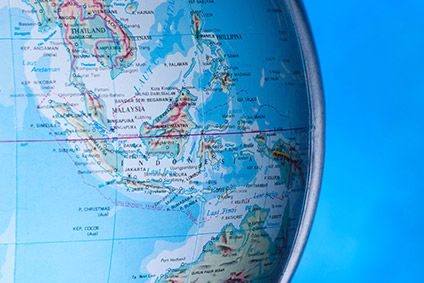
Textiles and apparel are, without a doubt, global industries. However, analysis by Dr Sheng Lu, associate professor in the Department of Fashion and Apparel Studies at the University of Delaware, based on the re:source by just-style sourcing tool and data from UN Comtrade, suggests world textile and apparel trade is also becoming more regional.
The importance of regional patterns in world textile and apparel trade reflects both the changing dynamics of the global economy and the shifting sourcing strategies of fashion brands and retailers.
As illustrated in Tables 1 and 2, three regions in the world – Asia, the European Union (EU) and Western Hemisphere (which includes North, Central and South America) – increasingly dominate world textile and apparel exports. Specifically:
Regarding textiles, in 2017 as much as 61.2% of global textile exports came from Asian countries, a new record high and much greater than the 30-40% a decade ago (Table 1). The European Union (EU) as a whole was the second-largest source of textiles, accounting for around 22-25% of world market share in the past ten years. About 5% of world textile exports came from North America (mainly the United States). However, other than the top three, textile exports from the rest of the world have shrunk significantly from 14% in 2007 to only 8.6% in 2017.
Similarly, Asia, the EU and the Western Hemisphere together accounted for 85% of world apparel exports in 2017, almost no change compared with a decade ago. Even though fashion brands and apparel retailers are gradually diversifying their sourcing bases, Asia still supplied a solid 56% of the total in 2017, followed by the EU (25.2%) and Western Hemisphere (3.6%). In comparison, just 15% of exports came from regions other than these top three in 2017, down from 18% back in 2000.
How well do you really know your competitors?
Access the most comprehensive Company Profiles on the market, powered by GlobalData. Save hours of research. Gain competitive edge.

Thank you!
Your download email will arrive shortly
Not ready to buy yet? Download a free sample
We are confident about the unique quality of our Company Profiles. However, we want you to make the most beneficial decision for your business, so we offer a free sample that you can download by submitting the below form
By GlobalDataSee Also:
The deepening of the regional production and trade network (RPTN) is a key factor behind the increasing concentration of world textile and apparel exports. RPTN refers to the phenomenon that geographically proximate countries form a regional supply chain. In general, three primary textile and apparel regional supply chains are operating in the world today:
#1: Asia – Within this regional supply chain, more economically advanced Asian countries (such as Japan, South Korea and China) supply textile raw material to the less economically developed countries in the region (such as Bangladesh, Cambodia and Vietnam). With their relatively lower wages, the less developed countries typically undertake the most labour-intensive apparel manufacturing processes and then export finished apparel to major consumption markets around the world. In addition, various regional free trade agreements – such as the ASEAN-China Free Trade Agreement and the ASEAN-Japan Comprehensive Economic Partnership Agreement – have also helped through the elimination of tariff and non-tariff barriers.
#2: Europe – Here developed countries in Southern and Western Europe (such as Italy, France and Germany) serve as the primary textile suppliers. In apparel manufacturing, mass market products are typically produced by developing countries in Southern and Eastern Europe (such as Poland and Romania), whereas high-end luxury products are mostly produced by Southern and Western European countries (such as Italy and France). Furthermore, a high portion of finished apparel is shipped to developed EU members such as UK, Germany, France and Italy for consumption. In addition, thanks to the EU single market, textile and apparel trade between EU members has a zero tariff rate and minimal non-tariff barriers.
#3: Western Hemisphere – Within this regional supply chain, the US serves as the leading textile supplier, whereas developing countries in North, Central and South America (such as Mexico and countries in the Caribbean region) assemble imported textiles from the US or elsewhere into apparel. The majority of clothing produced in the area is eventually exported to the US or Canada for consumption. As in Asia and the EU, the North American Free Trade Agreement (NAFTA) and the Dominican Republic-Central America Free Trade Agreement (DR-CAFTA) have played a critical role in shaping and supporting the Western Hemisphere supply chain.
Linked to these these regional production and trade networks, three particular trade flows are important to watch:
First, Asian countries are increasingly sourcing textile inputs from within the region. In 2017, close to 80% of Asian countries’ textile imports came from other Asian countries, up from around 70% in the 2000s (Table 3). This change reflects the formation of an ever more integrated regional textile and apparel supply chain in Asia. However, the other side is also true: as Asian countries become more economically integrated, textile and apparel producers in other parts of the world may find it increasingly difficult to get involved in the region. We expect this trend to continue with the implementation of several free trade agreements currently under negotiation among Asian countries, particularly the Regional Comprehensive and Economic Partnership (RCEP).
Second, the pattern of EU intra-regional trade for textiles and apparel remains strong and stable. Intra-regional trade refers to trade flows between EU members. In 2017, 55% of EU textile imports and 47% of EU apparel imports came from within the EU region. Over the same period, 68% of their textile exports and 75% of their apparel exports also went to other EU countries (Table 3 and 4). EU intra-regional trade for both textiles and apparel seems to be resistant to unfavourable external factors, such as the region’s high labour cost and competition from Asian suppliers over the past decade. However, the uncertainty created by Brexit may post new challenges down the road. As a reflection of the close connection between the UK and the rest of the EU, 67% and 79% of the UK’s textile and apparel exports respectively went to other EU members in 2017. At the same time, 45% and 31% of the UK’s textile and apparel imports also came from the EU.
Third, trade flows in the Western Hemisphere textile and apparel supply chain are becoming more unbalanced. On the one hand, 80% of textile exports and 89% of apparel exports from countries in the Western Hemisphere in 2017 went to the same region. However, on the other, the Western Hemisphere supply chain is facing growing competition from Asian suppliers. For example, in 2017, only 24.8% of North, South and Central American countries’ textile imports, and 15.7% of their apparel imports, came from within the region – a record low in the past ten years. If regional free trade agreements, such as NAFTA and DR-CAFTA, no longer existed, it would be even more difficult for the Western Hemisphere textile and apparel supply chain to survive. For the same reason, the region’s textile and apparel producers did not regret the US withdrawal from the Trans-Pacific Partnership (TPP). As studies indicated, if ‘Made in Vietnam’ apparel had been given duty-free access to the US market under TPP, apparel producers in Mexico and DR-CAFTA countries would have been vulnerable to the competition, which in turn would have had a negative impact on US textile mills.
Note: In Tables 3 and 4, “WH” refers to Western Hemisphere, which includes North, South and Central America.
Looking ahead, it will be interesting to see how will the conclusion and implementation of several new free trade agreements will affect regional patterns of world textile and apparel trade. For example:
- The Comprehensive and Progressive Agreement of the Trans-Pacific Partnership (CPTPP), which will take effect on 30 Dec 2018 and include all TPP members except the United States.
- The Regional Comprehensive and Economic Partnership (RCEP), which includes member states of the Association of Southeast Asian Nations (ASEAN) and other six economies in the Asia-Pacific region (Australia, China, India, Japan, South Korea and New Zealand).
- The EU-Japan Free Trade Agreement, which was reached in December 2017 and is likely to be implemented in 2019.
- The US-EU Free Trade Agreement and the US-Japan Free Trade Agreement, which will enter into negotiation in 2019.
The detailed rules of origin provisions in these trade agreements, in particular, could either shape new regional supply chains or weaken existing ones.








